Analysis of Mental Health & Wellbeing: Nursing/Midwifery Interventions
VerifiedAdded on 2023/06/05
|5
|1202
|367
Homework Assignment
AI Summary
This assignment provides a detailed analysis of a mental health case study, focusing on identifying urgent risk areas such as suicidal ideation and mental health concerns like acute depression. It outlines specific nursing and midwifery interventions to address these issues, including creating a risk-free environment, counseling sessions, and mindfulness-based cognitive behavioral therapy. The assignment also discusses legal, ethical, and professional considerations for nurses and midwives working with clients in similar situations, such as addressing professional designation disparities and overcoming the stigma associated with men seeking mental health support. The interventions are supported by relevant literature, emphasizing the importance of a holistic and sensitive approach to promoting mental health and wellbeing. Desklib offers a range of similar solved assignments and study resources for students.
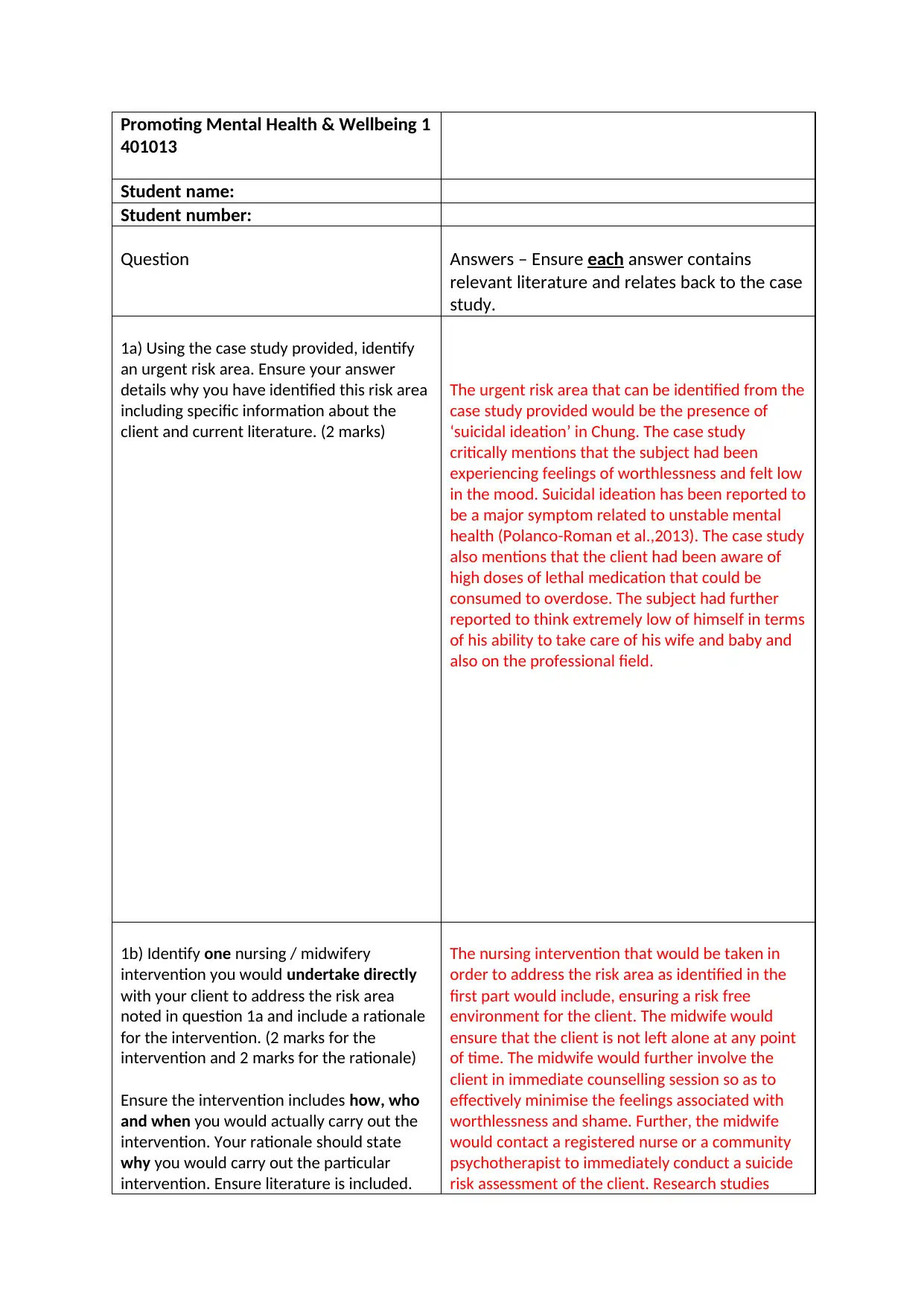
Promoting Mental Health & Wellbeing 1
401013
Student name:
Student number:
Question Answers – Ensure each answer contains
relevant literature and relates back to the case
study.
1a) Using the case study provided, identify
an urgent risk area. Ensure your answer
details why you have identified this risk area
including specific information about the
client and current literature. (2 marks)
The urgent risk area that can be identified from the
case study provided would be the presence of
‘suicidal ideation’ in Chung. The case study
critically mentions that the subject had been
experiencing feelings of worthlessness and felt low
in the mood. Suicidal ideation has been reported to
be a major symptom related to unstable mental
health (Polanco-Roman et al.,2013). The case study
also mentions that the client had been aware of
high doses of lethal medication that could be
consumed to overdose. The subject had further
reported to think extremely low of himself in terms
of his ability to take care of his wife and baby and
also on the professional field.
1b) Identify one nursing / midwifery
intervention you would undertake directly
with your client to address the risk area
noted in question 1a and include a rationale
for the intervention. (2 marks for the
intervention and 2 marks for the rationale)
Ensure the intervention includes how, who
and when you would actually carry out the
intervention. Your rationale should state
why you would carry out the particular
intervention. Ensure literature is included.
The nursing intervention that would be taken in
order to address the risk area as identified in the
first part would include, ensuring a risk free
environment for the client. The midwife would
ensure that the client is not left alone at any point
of time. The midwife would further involve the
client in immediate counselling session so as to
effectively minimise the feelings associated with
worthlessness and shame. Further, the midwife
would contact a registered nurse or a community
psychotherapist to immediately conduct a suicide
risk assessment of the client. Research studies
401013
Student name:
Student number:
Question Answers – Ensure each answer contains
relevant literature and relates back to the case
study.
1a) Using the case study provided, identify
an urgent risk area. Ensure your answer
details why you have identified this risk area
including specific information about the
client and current literature. (2 marks)
The urgent risk area that can be identified from the
case study provided would be the presence of
‘suicidal ideation’ in Chung. The case study
critically mentions that the subject had been
experiencing feelings of worthlessness and felt low
in the mood. Suicidal ideation has been reported to
be a major symptom related to unstable mental
health (Polanco-Roman et al.,2013). The case study
also mentions that the client had been aware of
high doses of lethal medication that could be
consumed to overdose. The subject had further
reported to think extremely low of himself in terms
of his ability to take care of his wife and baby and
also on the professional field.
1b) Identify one nursing / midwifery
intervention you would undertake directly
with your client to address the risk area
noted in question 1a and include a rationale
for the intervention. (2 marks for the
intervention and 2 marks for the rationale)
Ensure the intervention includes how, who
and when you would actually carry out the
intervention. Your rationale should state
why you would carry out the particular
intervention. Ensure literature is included.
The nursing intervention that would be taken in
order to address the risk area as identified in the
first part would include, ensuring a risk free
environment for the client. The midwife would
ensure that the client is not left alone at any point
of time. The midwife would further involve the
client in immediate counselling session so as to
effectively minimise the feelings associated with
worthlessness and shame. Further, the midwife
would contact a registered nurse or a community
psychotherapist to immediately conduct a suicide
risk assessment of the client. Research studies
Paraphrase This Document
Need a fresh take? Get an instant paraphrase of this document with our AI Paraphraser
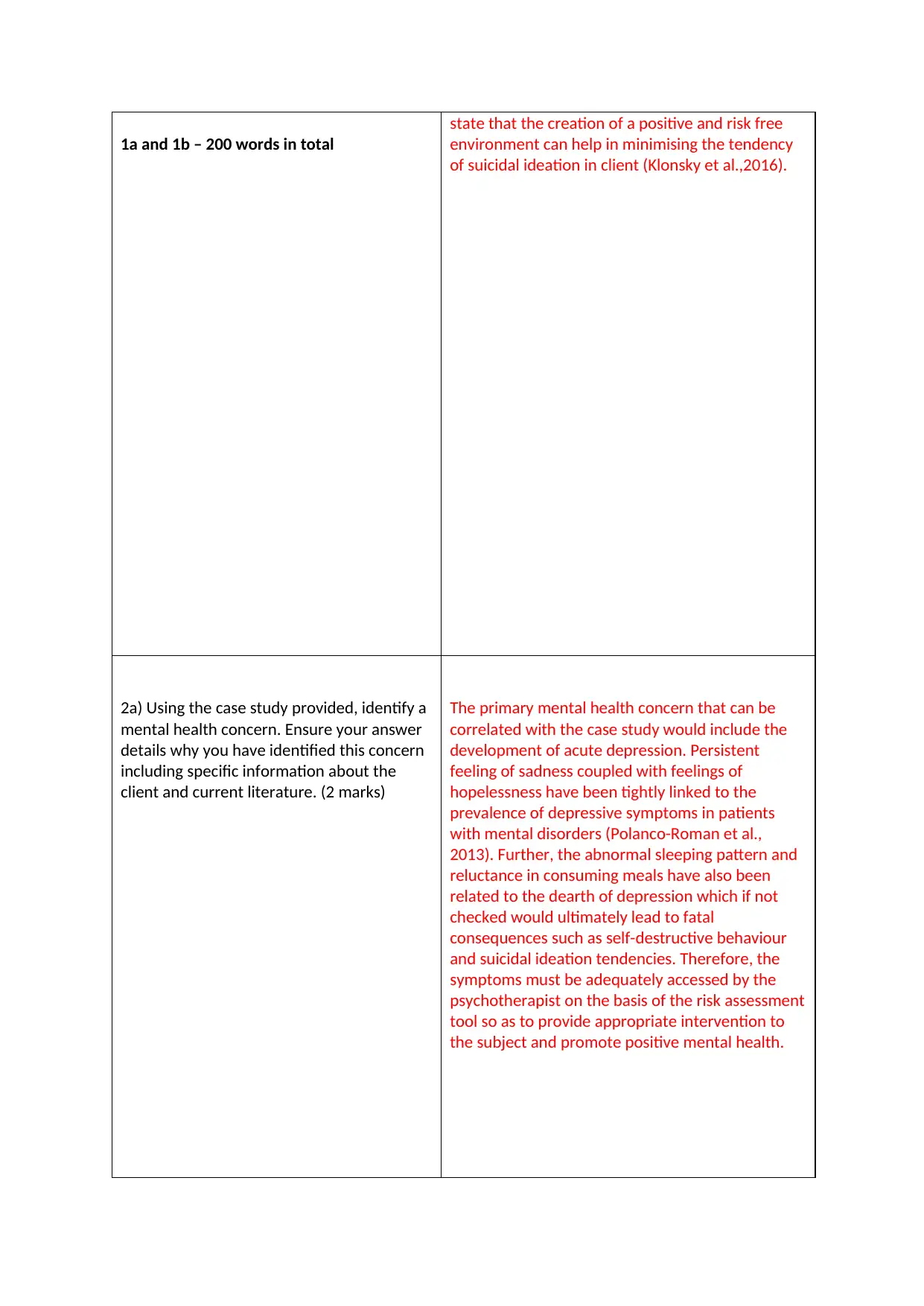
1a and 1b – 200 words in total
state that the creation of a positive and risk free
environment can help in minimising the tendency
of suicidal ideation in client (Klonsky et al.,2016).
2a) Using the case study provided, identify a
mental health concern. Ensure your answer
details why you have identified this concern
including specific information about the
client and current literature. (2 marks)
The primary mental health concern that can be
correlated with the case study would include the
development of acute depression. Persistent
feeling of sadness coupled with feelings of
hopelessness have been tightly linked to the
prevalence of depressive symptoms in patients
with mental disorders (Polanco-Roman et al.,
2013). Further, the abnormal sleeping pattern and
reluctance in consuming meals have also been
related to the dearth of depression which if not
checked would ultimately lead to fatal
consequences such as self-destructive behaviour
and suicidal ideation tendencies. Therefore, the
symptoms must be adequately accessed by the
psychotherapist on the basis of the risk assessment
tool so as to provide appropriate intervention to
the subject and promote positive mental health.
state that the creation of a positive and risk free
environment can help in minimising the tendency
of suicidal ideation in client (Klonsky et al.,2016).
2a) Using the case study provided, identify a
mental health concern. Ensure your answer
details why you have identified this concern
including specific information about the
client and current literature. (2 marks)
The primary mental health concern that can be
correlated with the case study would include the
development of acute depression. Persistent
feeling of sadness coupled with feelings of
hopelessness have been tightly linked to the
prevalence of depressive symptoms in patients
with mental disorders (Polanco-Roman et al.,
2013). Further, the abnormal sleeping pattern and
reluctance in consuming meals have also been
related to the dearth of depression which if not
checked would ultimately lead to fatal
consequences such as self-destructive behaviour
and suicidal ideation tendencies. Therefore, the
symptoms must be adequately accessed by the
psychotherapist on the basis of the risk assessment
tool so as to provide appropriate intervention to
the subject and promote positive mental health.
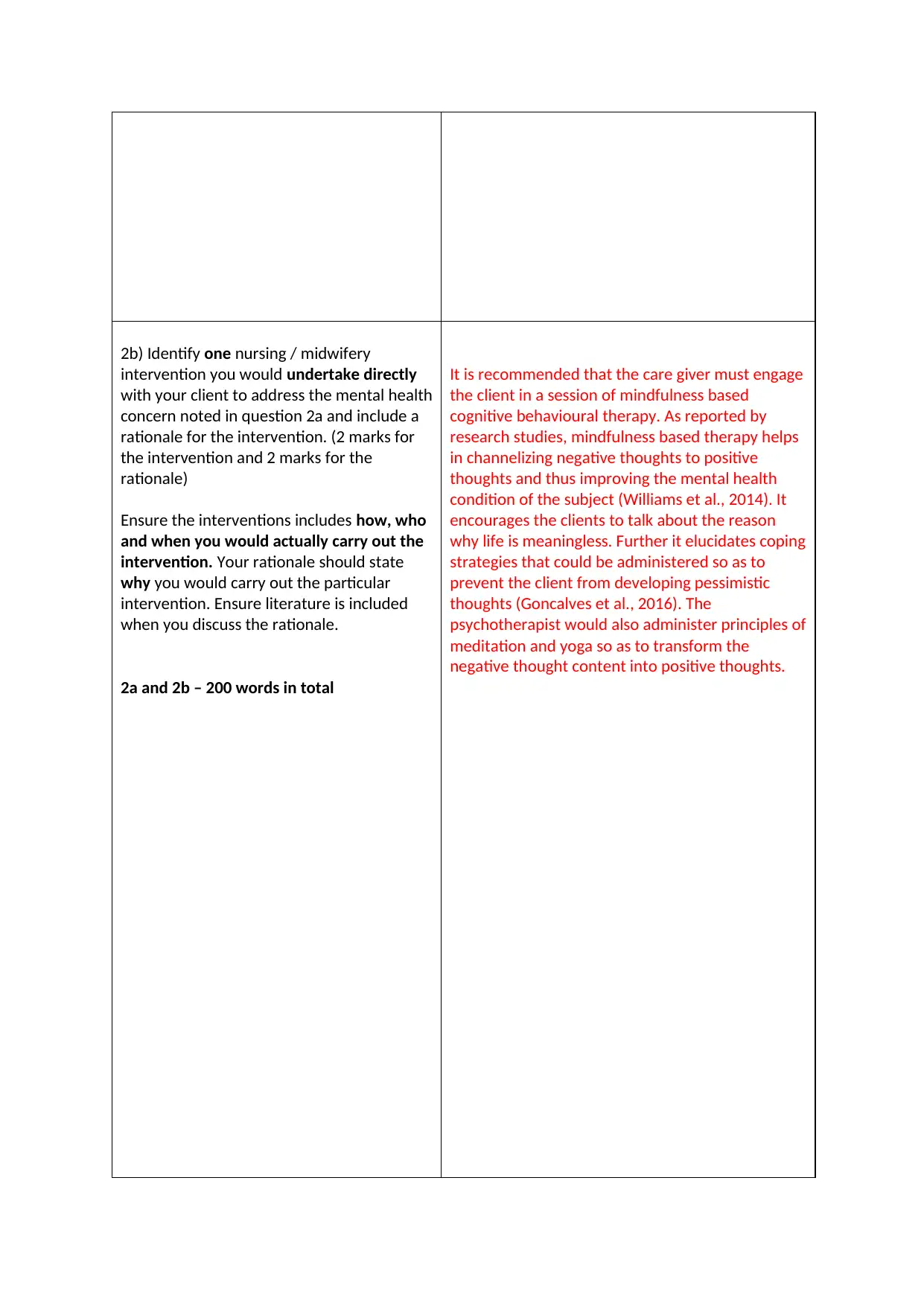
2b) Identify one nursing / midwifery
intervention you would undertake directly
with your client to address the mental health
concern noted in question 2a and include a
rationale for the intervention. (2 marks for
the intervention and 2 marks for the
rationale)
Ensure the interventions includes how, who
and when you would actually carry out the
intervention. Your rationale should state
why you would carry out the particular
intervention. Ensure literature is included
when you discuss the rationale.
2a and 2b – 200 words in total
It is recommended that the care giver must engage
the client in a session of mindfulness based
cognitive behavioural therapy. As reported by
research studies, mindfulness based therapy helps
in channelizing negative thoughts to positive
thoughts and thus improving the mental health
condition of the subject (Williams et al., 2014). It
encourages the clients to talk about the reason
why life is meaningless. Further it elucidates coping
strategies that could be administered so as to
prevent the client from developing pessimistic
thoughts (Goncalves et al., 2016). The
psychotherapist would also administer principles of
meditation and yoga so as to transform the
negative thought content into positive thoughts.
intervention you would undertake directly
with your client to address the mental health
concern noted in question 2a and include a
rationale for the intervention. (2 marks for
the intervention and 2 marks for the
rationale)
Ensure the interventions includes how, who
and when you would actually carry out the
intervention. Your rationale should state
why you would carry out the particular
intervention. Ensure literature is included
when you discuss the rationale.
2a and 2b – 200 words in total
It is recommended that the care giver must engage
the client in a session of mindfulness based
cognitive behavioural therapy. As reported by
research studies, mindfulness based therapy helps
in channelizing negative thoughts to positive
thoughts and thus improving the mental health
condition of the subject (Williams et al., 2014). It
encourages the clients to talk about the reason
why life is meaningless. Further it elucidates coping
strategies that could be administered so as to
prevent the client from developing pessimistic
thoughts (Goncalves et al., 2016). The
psychotherapist would also administer principles of
meditation and yoga so as to transform the
negative thought content into positive thoughts.
⊘ This is a preview!⊘
Do you want full access?
Subscribe today to unlock all pages.

Trusted by 1+ million students worldwide
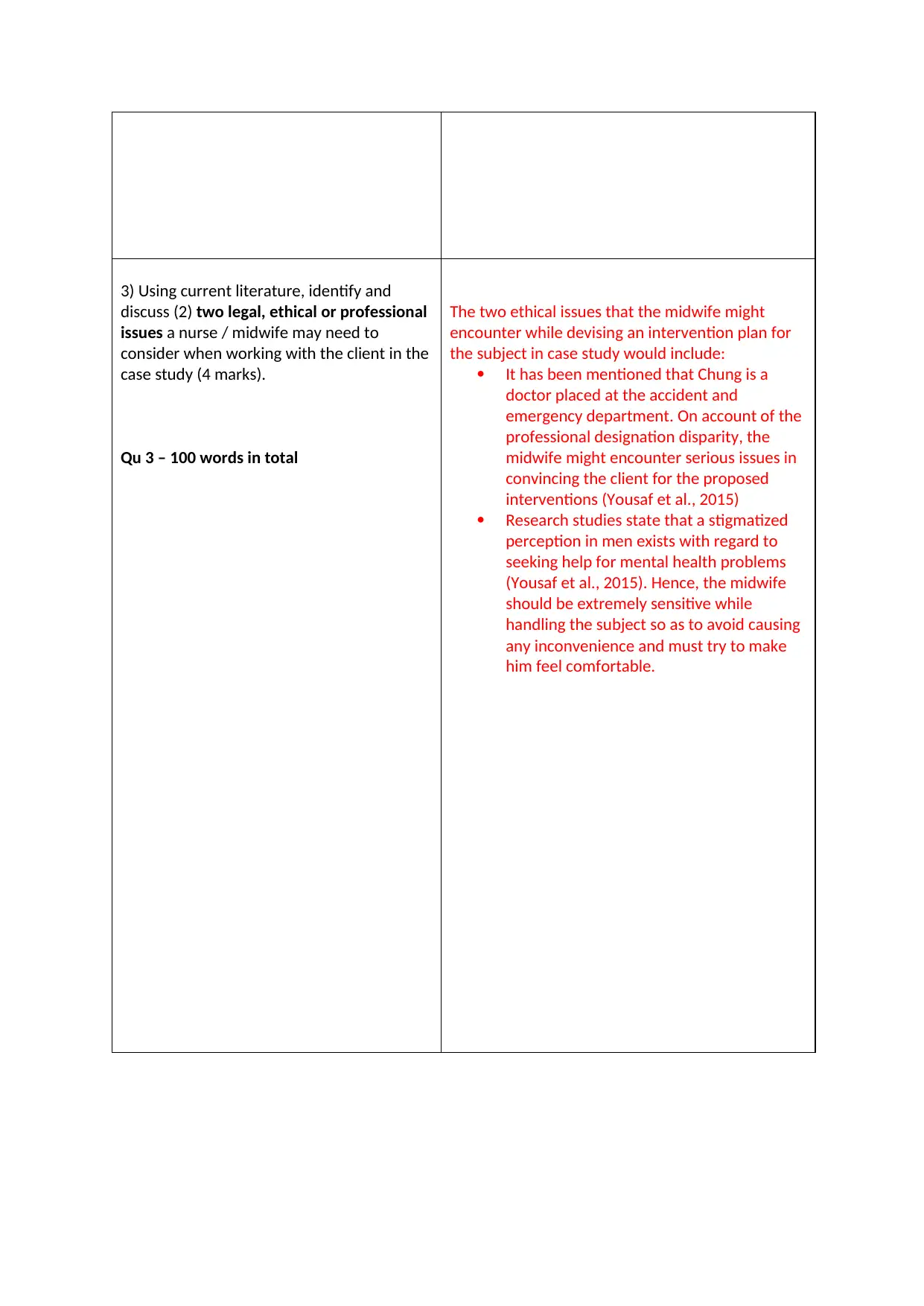
3) Using current literature, identify and
discuss (2) two legal, ethical or professional
issues a nurse / midwife may need to
consider when working with the client in the
case study (4 marks).
Qu 3 – 100 words in total
The two ethical issues that the midwife might
encounter while devising an intervention plan for
the subject in case study would include:
It has been mentioned that Chung is a
doctor placed at the accident and
emergency department. On account of the
professional designation disparity, the
midwife might encounter serious issues in
convincing the client for the proposed
interventions (Yousaf et al., 2015)
Research studies state that a stigmatized
perception in men exists with regard to
seeking help for mental health problems
(Yousaf et al., 2015). Hence, the midwife
should be extremely sensitive while
handling the subject so as to avoid causing
any inconvenience and must try to make
him feel comfortable.
discuss (2) two legal, ethical or professional
issues a nurse / midwife may need to
consider when working with the client in the
case study (4 marks).
Qu 3 – 100 words in total
The two ethical issues that the midwife might
encounter while devising an intervention plan for
the subject in case study would include:
It has been mentioned that Chung is a
doctor placed at the accident and
emergency department. On account of the
professional designation disparity, the
midwife might encounter serious issues in
convincing the client for the proposed
interventions (Yousaf et al., 2015)
Research studies state that a stigmatized
perception in men exists with regard to
seeking help for mental health problems
(Yousaf et al., 2015). Hence, the midwife
should be extremely sensitive while
handling the subject so as to avoid causing
any inconvenience and must try to make
him feel comfortable.
Paraphrase This Document
Need a fresh take? Get an instant paraphrase of this document with our AI Paraphraser
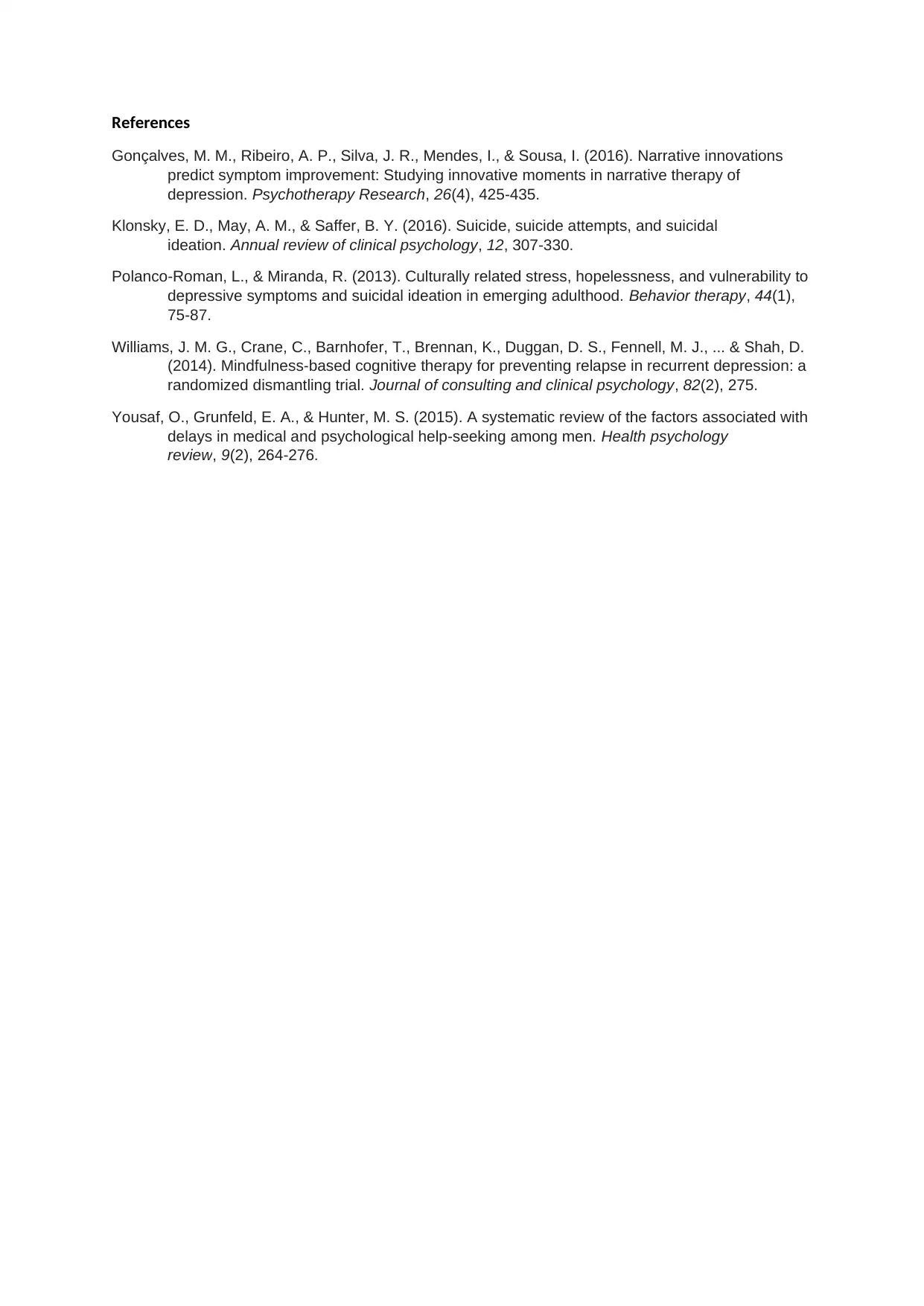
References
Gonçalves, M. M., Ribeiro, A. P., Silva, J. R., Mendes, I., & Sousa, I. (2016). Narrative innovations
predict symptom improvement: Studying innovative moments in narrative therapy of
depression. Psychotherapy Research, 26(4), 425-435.
Klonsky, E. D., May, A. M., & Saffer, B. Y. (2016). Suicide, suicide attempts, and suicidal
ideation. Annual review of clinical psychology, 12, 307-330.
Polanco-Roman, L., & Miranda, R. (2013). Culturally related stress, hopelessness, and vulnerability to
depressive symptoms and suicidal ideation in emerging adulthood. Behavior therapy, 44(1),
75-87.
Williams, J. M. G., Crane, C., Barnhofer, T., Brennan, K., Duggan, D. S., Fennell, M. J., ... & Shah, D.
(2014). Mindfulness-based cognitive therapy for preventing relapse in recurrent depression: a
randomized dismantling trial. Journal of consulting and clinical psychology, 82(2), 275.
Yousaf, O., Grunfeld, E. A., & Hunter, M. S. (2015). A systematic review of the factors associated with
delays in medical and psychological help-seeking among men. Health psychology
review, 9(2), 264-276.
Gonçalves, M. M., Ribeiro, A. P., Silva, J. R., Mendes, I., & Sousa, I. (2016). Narrative innovations
predict symptom improvement: Studying innovative moments in narrative therapy of
depression. Psychotherapy Research, 26(4), 425-435.
Klonsky, E. D., May, A. M., & Saffer, B. Y. (2016). Suicide, suicide attempts, and suicidal
ideation. Annual review of clinical psychology, 12, 307-330.
Polanco-Roman, L., & Miranda, R. (2013). Culturally related stress, hopelessness, and vulnerability to
depressive symptoms and suicidal ideation in emerging adulthood. Behavior therapy, 44(1),
75-87.
Williams, J. M. G., Crane, C., Barnhofer, T., Brennan, K., Duggan, D. S., Fennell, M. J., ... & Shah, D.
(2014). Mindfulness-based cognitive therapy for preventing relapse in recurrent depression: a
randomized dismantling trial. Journal of consulting and clinical psychology, 82(2), 275.
Yousaf, O., Grunfeld, E. A., & Hunter, M. S. (2015). A systematic review of the factors associated with
delays in medical and psychological help-seeking among men. Health psychology
review, 9(2), 264-276.
1 out of 5
Related Documents
Your All-in-One AI-Powered Toolkit for Academic Success.
+13062052269
info@desklib.com
Available 24*7 on WhatsApp / Email
![[object Object]](/_next/static/media/star-bottom.7253800d.svg)
Unlock your academic potential
Copyright © 2020–2025 A2Z Services. All Rights Reserved. Developed and managed by ZUCOL.


